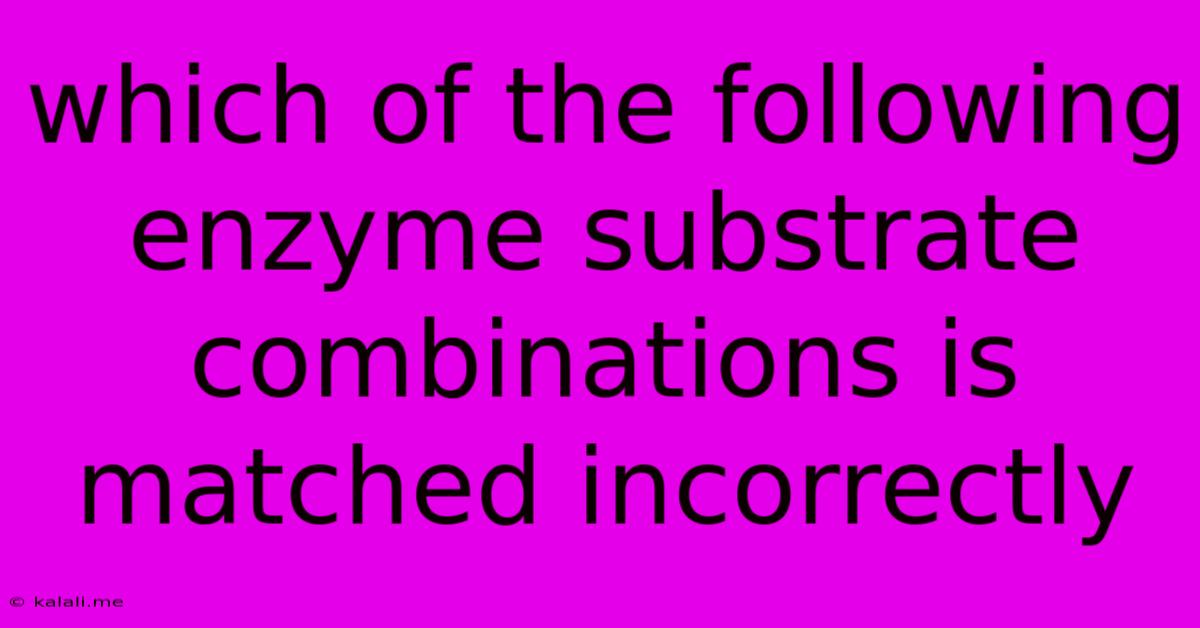Which Of The Following Enzyme Substrate Combinations Is Matched Incorrectly
Kalali
Jun 13, 2025 · 3 min read

Table of Contents
Which of the Following Enzyme-Substrate Combinations is Matched Incorrectly? A Guide to Enzyme Specificity
Enzymes are biological catalysts that speed up chemical reactions within living organisms. Their incredible efficiency stems from their high specificity for particular substrates. This specificity is crucial for the precise regulation of metabolic pathways. This article will explore enzyme-substrate pairings, focusing on identifying incorrectly matched combinations and understanding the principles behind enzyme-substrate interactions. Understanding enzyme specificity is crucial for fields such as medicine, biotechnology, and biochemistry.
Understanding Enzyme-Substrate Interactions
Enzymes possess unique three-dimensional structures, including an active site. The active site is a region with a specific shape and chemical properties that perfectly complement the substrate, the molecule upon which the enzyme acts. This "lock and key" model, while a simplification, illustrates the principle of complementary shapes facilitating binding. The induced fit model provides a more nuanced perspective, suggesting the enzyme's shape can slightly change upon substrate binding, optimizing the interaction.
Common Enzyme-Substrate Pairs
Many enzyme-substrate combinations are well-established in biochemistry. For example:
- Amylase and Starch: Amylase, a digestive enzyme, breaks down starch (a polysaccharide) into simpler sugars like maltose.
- Lactase and Lactose: Lactase hydrolyzes lactose, a disaccharide found in milk, into glucose and galactose.
- Proteases and Proteins: Proteases are a broad class of enzymes that cleave peptide bonds in proteins, breaking them down into smaller peptides or amino acids. Examples include pepsin and trypsin.
- Lipase and Lipids: Lipases catalyze the hydrolysis of fats (lipids) into fatty acids and glycerol.
Identifying Incorrectly Matched Enzyme-Substrate Combinations
To identify an incorrectly matched pair, one must consider the enzyme's known function and the substrate's chemical structure. An incorrect pairing might involve:
- A substrate lacking the necessary functional groups: The enzyme's active site might require specific chemical groups (e.g., hydroxyl, carboxyl) on the substrate for proper binding and catalysis. If these groups are absent, the reaction won't proceed.
- Steric hindrance: The substrate's size or shape may prevent it from fitting into the enzyme's active site. This steric clash inhibits effective binding.
- Incorrect chemical environment: The optimal pH or temperature for enzyme activity might be incompatible with the substrate's stability, leading to ineffective catalysis or substrate degradation.
Example: Let's say a multiple-choice question presents several enzyme-substrate pairings, and one is demonstrably wrong due to the points above. Careful consideration of the enzyme's typical activity and the substrate's characteristics is vital for accurate identification.
Factors Affecting Enzyme Activity
Several factors can influence enzyme activity and therefore affect the efficiency of the enzyme-substrate interaction. These factors include:
- Temperature: Enzymes have an optimal temperature range. Too high or too low temperatures can denature the enzyme, altering its shape and reducing its activity.
- pH: Similar to temperature, each enzyme operates best within a specific pH range.
- Substrate concentration: Increasing substrate concentration initially increases the reaction rate, but eventually plateaus when all enzyme active sites are saturated.
- Enzyme concentration: Higher enzyme concentration generally leads to faster reaction rates, up to a point of saturation.
- Inhibitors: Certain molecules can bind to enzymes and either competitively or non-competitively inhibit their activity.
Understanding these factors is crucial to predicting the success of any given enzyme-substrate combination.
Conclusion
The correct matching of enzymes and substrates is fundamental to biochemical processes. Understanding the principles of enzyme specificity and the factors influencing enzyme activity allows for the accurate identification of incorrectly matched combinations. This knowledge is essential for various scientific disciplines and practical applications. By carefully considering the enzyme's function and the substrate's properties, one can confidently determine the validity of an enzyme-substrate pairing.
Latest Posts
Latest Posts
-
What Is The Prime Factorization Of 225
Jun 14, 2025
-
Write 80 As A Product Of Prime Factors
Jun 14, 2025
-
Magnetic Field Lines Inside A Bar Magnet
Jun 14, 2025
-
Which Of The Following Is True Of Classical Conditioning
Jun 14, 2025
-
Which Of The Following Is In The Correct Order
Jun 14, 2025
Related Post
Thank you for visiting our website which covers about Which Of The Following Enzyme Substrate Combinations Is Matched Incorrectly . We hope the information provided has been useful to you. Feel free to contact us if you have any questions or need further assistance. See you next time and don't miss to bookmark.